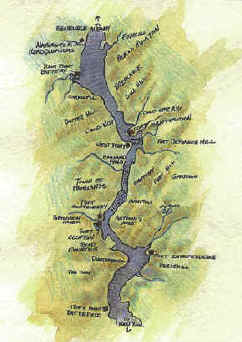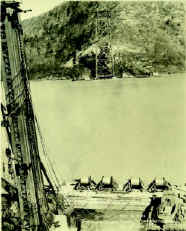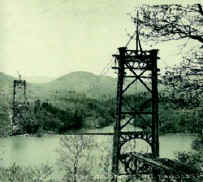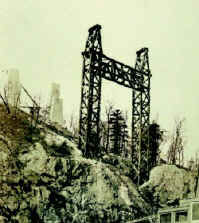|
|
Please be patient while pictures load. |
| Return to Main Bridge History Page | |
|
Back to |
|
|
Please be patient while pictures load. |
| Return to Main Bridge History Page | |
|
Back to |
|
The site of the Bear Mountain Bridge, the Highlands, has long been regarded as vital to the surrounding area. During the Revolutionary War, it was key to the success of the Colonial forces. If the British had won control of the area, they would have been able to link their forces in Canada and New York, blocking supply routes for the Americans. Later, in 1868, the first charter for a railroad bridge was obtained. Three attempts at construction were launched, but failed for a variety of reasons. In lieu of a passenger bridge, ferries were used in the early 1900's to transfer people across the river. Bear Mountain State Park, opened in 1916, quickly became a popular attraction for New Yorkers, and began to strain the carrying capacity of the ferries. |
 |
| Getting to the Park often meant waiting hours at the ferry landings to cross, or not crossing at all late at night or when ice covered the river. People slept in their cars when the small local hotels became full. The need for a highway bridge between Albany and New York City was apparent by the early 1920's. | |
 |
The most practical location for a bridge was at the narrow entrance to the Highlands. New technology would allow an attempt to cross the river with a suspension bridge, and recent construction of the Storm King Highway and Aqueduct Tunnel provided necessary geological information. Improvements in steel production and methods of steel cable-spinning also reduced time and cost dramatically. These circumstances prompted a group of entrepreneurs to begin work on a bridge. | |
| In February, 1922, a bill was introduced in the state legislature which authorized | 
|
|
| the creation of a corporation to build a bridge across the Hudson. Under the terms of the Special Act, the company was given 30 years to build the bridge and highway approaches on state-owned land. The Bear Mountain Hudson River Bridge Company, privately financed by stockholders, was to construct and operate the bridge for 30 years, after which it would become the property of the state. | ||
|
The time limit on the construction of the bridge meant that steel rather than masonry towers would have to be used. The proposed bridge and highway design aroused public outcry over the impact they would have on the beauty of the Highlands. In The Outlook in July 1923, Lawrence Abbott wrote that "it looks in its wonderful setting of mountains and river, like a piece of tin frumpery." The criticism led Baird & Hodge to modify the steel design, changing the portals to give more of a 'tunnel-like' appearance to echo the bridge's surroundings. |
 |
|